#helium-3-market
Explore tagged Tumblr posts
Text
Amazon SEO Tips for E-commerce Brands
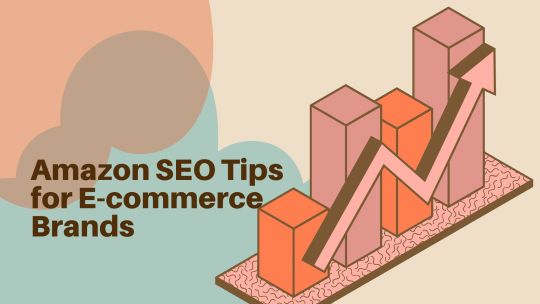
In today's digital age, e-commerce has seen tremendous growth, and Amazon remains one of the giants in the industry. With millions of products available on this platform, getting noticed can be a real challenge. This is where Amazon SEO Optimization becomes crucial. To help e-commerce brands succeed, here are some effective Amazon SEO tips.
1. Understanding Amazon's A9 Algorithm
Before diving into SEO strategies, it's essential to grasp how Amazon's A9 algorithm works. A9 is Amazon's search engine, and understanding its intricacies is the foundation of successful Amazon SEO. It's worth noting that A9 differs from Google's algorithm. While Google aims to provide information, Amazon's primary goal is to generate sales. Therefore, the factors that influence rankings on Amazon are unique.
2. Keyword Research and Optimization
Keywords are the backbone of Amazon SEO. Start with in-depth Amazon keyword research to identify high-value, relevant keywords for your products. Utilise tools like Merchant Words, Helium 10, or Amazon's own keyword tool. When crafting product descriptions, weave the keyword into the narrative seamlessly. Describe what makes your product stand out and why it's a one-of-a-kind find for customers.
3. Compelling Product Titles and Descriptions
Your product title is the first thing customers see. It should be both descriptive and compelling. Balancing clarity and creativity is essential. Ensure that the most important keywords are present in the title while making it engaging. For product Product ranking on Amazon descriptions, provide detailed information about the product's features, benefits, and usage.
4. Optimizing Product Images
High-quality images are crucial for conversions. Optimize your product images by ensuring they meet Amazon's image requirements. Use high-resolution images, showcase the product from different angles, and include lifestyle images when possible. Don't forget to include relevant keywords in the image file names and alt text.
5. Enhanced Brand Content and A+ Content
Enhanced Brand Content (EBC) and A+ Content offer a unique opportunity to tell your brand's story and highlight product features. Create engaging content modules with high-quality images, infographics, and multimedia elements. This not only enhances your product listings but also positively influences SEO.
6. Maintaining Competitive Pricing
Pricing is a critical factor for both conversions and SEO. Competitive pricing can improve your chances of winning the Buy Box and attract more customers. By offering a unique pricing structure, you can set yourself apart from competitors.
7. Managing Customer Reviews and Ratings
Positive customer reviews and high ratings are not only crucial for credibility but also for SEO. Fostering a unique culture of customer engagement is key to a thriving Amazon presence. Actively encourage contented customers to share their experiences through reviews, and swiftly attend to any distinctive negative feedback.
8. Fulfillment by Amazon (FBA) Benefits
Utilizing Fulfillment by Amazon (FBA) can enhance your SEO efforts. FBA products often qualify for Prime eligibility, which can lead to higher visibility and more conversions. Consider using FBA for your best-selling items.
9. Monitoring and Analyzing Performance
Regularly monitor your Amazon SEO performance by tracking key metrics like click-through rates, conversion rates, and sales. This data-driven approach allows you to make informed decisions that set your e-commerce business apart.
10. Building External Traffic Sources
Driving external traffic to your Amazon listing optimization can also Boost your rankings. Use social media marketing, email marketing, and influencer partnerships to direct traffic to your Amazon store. The more external traffic you generate, the more Amazon will favor your products.
Conclusion
Amazon SEO is a dynamic field, and staying competitive requires constant adaptation and learning. By implementing these Amazon SEO tips, you can enhance your brand's visibility, attract more customers, and ultimately drive sales on one of the world's most prominent e-commerce platforms.
Remember that Amazon's algorithm evolves, so staying updated with the latest trends and best practices is vital to maintaining your competitive edge.
Incorporate these strategies into your Amazon marketing plan and watch your e-commerce brand thrive in the highly competitive world of online retail.
#digitalmarketingcourse#digitalmarketingclassesnearme#digitalmarketingcoursenearme#digitalmarketinginstitutenearme#seocoursenearme
2 notes
·
View notes
Note
Shoyo-Bestgirl Feng
Autistic, Gremlin, Excited
Air (Void?)
Cold
Clean (More a constrained chaos)
High-Tech
Hard
Noble (but a scamp)
Violent but probably lack of context for otherwise
Unsure? Government or Corporate maybe?
Augmented (Genetic Enhancements)
Military Officer, Professional Go Player, Wildlife Caretaker
Swords and they're the sharpest ever, Is nonverbal so probably communicates in an alternative fashion to others from her mech
[ For I'll write an Armored Core VI Verse/AU for your muse ]
World: Uranus (Sol 7) Catalog Number: n/a Type: ice giant, various colonies Climate: artificial, temperate Population: 12 million Satellites: 27 Notable Features: orbital ring and dockyards
Helium-3, the lifeblood of the interstellar economy, is not an easy thing to acquire at industrial scales. Lunar deposits were costly to extract and rapidly overexploited to fuel human industry. While insatiable demand drove the early development of the Jupiter colonies, Jupiter's deep gravity well, intense radiation belts, and differentiated atmosphere made atmospheric mining at scale prohibitively costly. Saturn was ultimately little better, and the market was primed for a cheaper supply. Uranus, with a much weaker gravity well and more importantly still an unsettled distribution of helium, was exactly what humanity needed, despite being located at a markedly greater distance. The ease of extracting power from its magnetic field, which is tilted from the rotation of the planet, was another plus.
Today, Uranus hosts a largely automated helium-3 extraction industry, providing the bulk of the supply in Sol and neighboring systems. Atmospheric mining is conducted via massive atmospheric platforms—part aerostat, part aircraft—which routinely transfer their haul to low orbit via cargo drones. These are subsequently collected by skyhooks descending from the orbital ring. This ring, having been constructed through extensive mining of the Uranian moons, hosts most of the human population, and sustains itself using volatiles from the planet and ices from said moons. While the orbital ring is under the tight control of a unified governing authority practicing dirigiste economic policies, the resulting "national champion" corporations promote the interests of Uranus vigorously, not just in the remaining early colonies of closed O'Neill cylinders around the planet, or on its moons, but throughout the outer Solar System—much to the chagrin of the Jupiter colonies.
Name: Shoyo Fēng Augmentation: Generation Nine Occupation: corporate security officer Affiliation: Fēng Tactical Solutions Registration Number: Sl4649 Callsign: Tacit Armored Core: Intervals
Although most of the Uranian corporations have their own internal security details, external physical security is almost inevitably contracted to Fēng Tactical Solutions, which de facto constitutes the Uranian military and is publicly traded but majority-controlled by its namesake family. Given their limited recruitment pool and the need to function across a wide range of environments (so-called ECOAS operations—earth, colony, asteroid), the company places a particular emphasis on skill and first strike capability to minimize losses. Their defensive forces are limited and their offensive forces are organized into role-specific strike teams.
The newest member of the Fēng family to appear in the corporation's combat roster, Shoyo was initially assigned to a Muscle Tracer guard unit, but proved to be a poor fit for the duty assignment despite her stellar simulation scores. It was eventually judged that her talents were being wasted, and she was reassigned to an Armored Core-based reconnaissance and scouting team. The unit in question routinely dispatches its members solo and notably farther afield than the usual talking grounds of the outer Solar System, to include other systems.
While Shoyo's unusual text-and-gesture-only style of communication proved a hindrance in team formations, the cryptic impression it leaves has proven oddly fitting to her new line of work.

A fairly high-tech AC, Intervals was—perhaps somewhat paradoxically to those from more terrestrial backgrounds—constructed with melee combat in mind. Relatively nimble while retaining good armor and defense, it features higher stability for its weight.
Functionally a light assault unit, its typical combat pattern is closing with assault boost while using vertical plasma missiles to suppress targets, then continuing to apply pressure with its machine gun as it closes to melee range. The laser blade provides excellent mobility in this regime and can sweep multiple targets, while its laser slicer and assault armor make for devastating follow-ups. A nightmare once it's within enemy ranks, it also poses a substantial threat to any AC that would underestimate its close-range power.
#Out Of Character#maddmuses#Armored Core RP#Armored Core Roleplay#Long Post#Asks#Ask Games#[ Uranus is basically Space Norway ]
2 notes
·
View notes
Text
How to Start a successful Amazon FBA business in 2023? (Step-By-Step Guide)!
Starting an Amazon FBA (Fulfillment by Amazon) business is an excellent opportunity to create a profitable business with low overhead costs. FBA allows you to sell products on Amazon’s platform, while Amazon handles storage, shipping, and customer service. In this guide, we’ll take you through the steps to start a successful Amazon FBA business in 2023.
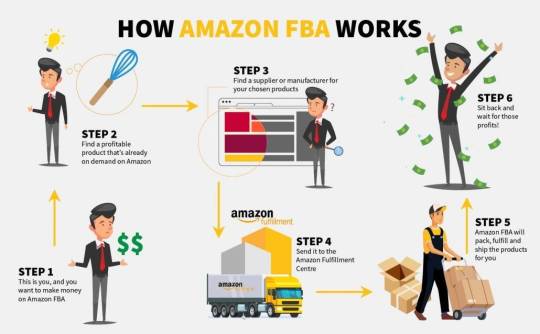
Step 1: Create an Amazon seller account The first step to starting an Amazon FBA business is to create an Amazon seller account. You can do this by visiting the Amazon Seller Central website and following the registration process. Amazon offers two types of seller accounts: individual and professional. Choose the type of account that best fits your needs and budget.
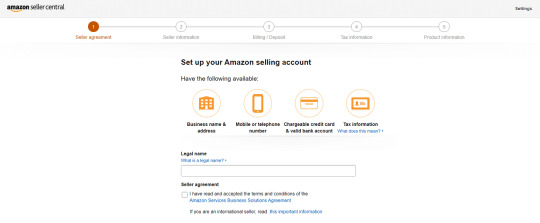
Step 2: Research profitable products The next step is to research profitable products that you can sell on Amazon. Look for products that have high demand, low competition, and a healthy profit margin. You can use Amazon’s Best Sellers list, Google Trends, and other market research tools to identify potential products.
One of the tools which helped me to reach 7-Figures in sales is Helium 10. This tool has many opportunities and training and when I started I was with 0 knowledge this tool helped me step-by-step to get into this business and to succeed.

Step 3: Find a supplier Once you’ve identified a product to sell, you need to find a reliable supplier. You can search for suppliers on Alibaba, Global Sources, and other B2B marketplaces. Look for suppliers with a good track record, competitive pricing, and the ability to meet your product specifications.
Alibaba is the right source to get a verified supplier at a reasonable price point. Always remember to connect and take prices with at least 15 suppliers and negotiate as much as you can.
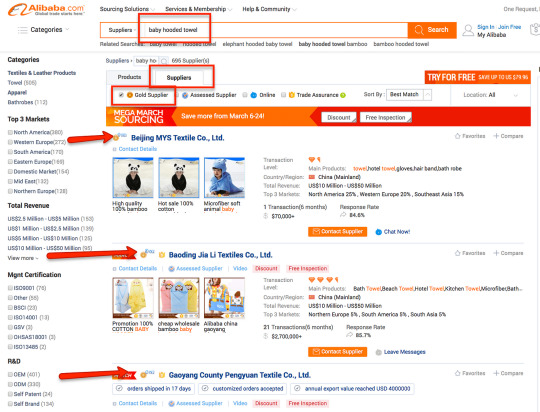
Step 4: Create a product listing With your product and supplier in place, the next step is to create a product listing on Amazon. Your product listing should include a title, bullet points, product description, and high-quality product images. Make sure to optimize your listing for Amazon’s search engine by using relevant keywords and including all the necessary product information.
This is the best time when you know everything is set and your product is going to be listed now. Just focus here is on getting Extraordinary photoshoots done for your products with the help of sample products you get from your supplier.
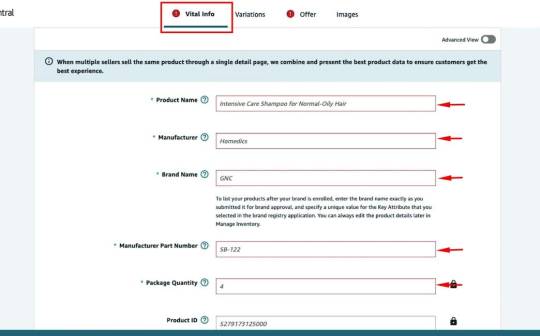
Step 5: Optimize your product listing Amazon’s search algorithm rewards listings that are optimized for the search engine. To optimize your listing, you should focus on the following areas: title, bullet points, description, and backend keywords. Make sure to use relevant keywords in each of these sections, but avoid keyword stuffing or using irrelevant keywords.
Optimization can be done in many ways. With 80% optimization things and steps Helium 10 will help you. Like to do keyword, Heading, Description, Key points, Images optimization.

Step 6: Launch your product With your product listing optimized, it’s time to launch your product. Use Amazon’s Pay Per Click (PPC) advertising platform to drive traffic to your product listing. Start with a small budget and gradually increase it as you get more sales.

Step 7: Monitor your performance As your product sells, make sure to monitor your performance metrics, such as your conversion rate, customer reviews, and seller feedback. Use this data to optimize your product listing and advertising campaigns.
Slightly, Monitor your performance and take action according to that if you are selling your products more than acceptations slow down your PPC and prepare to restock.

Step 8: Scale your business Once you’ve established a profitable product, you can start scaling your business by adding new products to your portfolio. Use the same research and optimization techniques to identify new products that will sell well on Amazon.
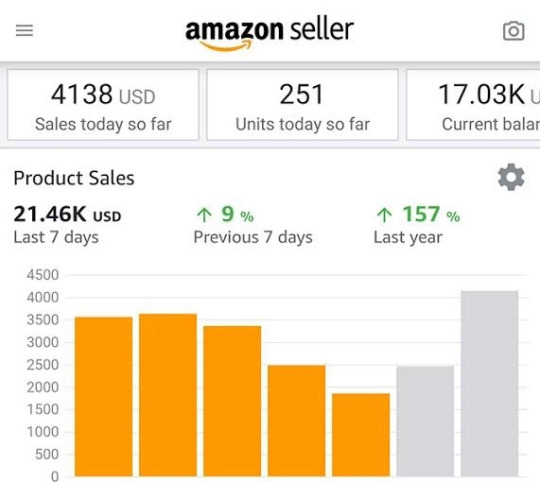
Conclusion: Starting a successful Amazon FBA business requires careful planning, research, and execution. By following the steps outlined in this guide, you can start your Amazon FBA business and build a profitable online business in 2023. Remember to stay focused, monitor your performance, and always be on the lookout for new opportunities to scale your business.
Just remember you are one product away! Focus on only improving and differentiating your product…
4 notes
·
View notes
Text
How to Do Product Research for Amazon: A Step-by-Step Advanced Guide

Amazon is a giant e-commerce platform where sellers compete fiercely for consumer attention. Whether you're a beginner or a seasoned seller, advanced product research is the foundation of your success. This guide will walk you through the latest strategies and techniques to identify winning products for your Amazon business in 2024 and beyond. Let's dive in!
Step 1: Analyze Market Trends
Use tools like Google Trends, Jungle Scout, or Helium 10 to identify products with rising demand. Cross-reference your findings with seasonal trends and categories that consistently perform well, like home decor, health products, and tech accessories.
Pro Tip: Pay attention to TikTok trends or viral products on Instagram and Pinterest. Social media often drives purchasing decisions.
Step 2: Target Untapped Niches
Avoid oversaturated markets by targeting underserved niches. Here’s how to spot them:
Look for products with high search volumes but relatively low competition.
Explore subcategories within trending sectors. For example, instead of generic fitness gear, consider niche items like resistance bands for seniors or compact workout gear for travelers.
Step 3: Evaluate Competitor Performance
Research your competitors to understand what’s working and where they fall short. Check their:
Product listings: Analyze titles, descriptions, and images.
Reviews: Note common complaints and areas for improvement.
Pricing: Understand the pricing dynamics and potential margins.
Pro Tip: Use Amazon’s "Frequently Bought Together" feature to identify complementary products you can bundle.
Step 4: Leverage Advanced Keyword Research
Identify high-performing keywords to boost your product's visibility. Use tools like:
Helium 10’s Magnet: For detailed keyword analysis.
Sonar by Sellics: To discover untapped keywords.
Amazon’s Auto-Suggest: For long-tail keyword ideas.
Pro Tip: Prioritize keywords with high search volume but low competition for maximum ROI.
Step 5: Validate Demand with Data
Before investing in inventory, validate demand using data-driven methods:
Check monthly search volume for your target product.
Analyze estimated sales for top-ranking listings.
Verify your product's potential profitability using FBA calculators.
Pro Tip: Conduct a small-scale test by launching a limited inventory to gauge demand and refine your strategy.
Step 6: Optimize Product Listings
Ensure your product stands out with a high-converting listing:
Use high-quality images and lifestyle shots.
Write compelling, keyword-optimized titles and bullet points.
Highlight unique selling points and benefits.
Step 7: Monitor & Adapt
Stay ahead by constantly monitoring market dynamics. Use analytics tools to track:
Conversion rates.
Customer feedback.
Competitor activities.
Pro Tip: Update your listings periodically to reflect seasonal trends and customer preferences.
Conclusion
Effective product research is an ongoing process that requires a mix of creativity, analytical thinking, and strategic execution. By following these advanced steps, you can uncover profitable products and thrive in the competitive Amazon marketplace.
0 notes
Text
How to Sell Wholesale on Amazon in 2025
Selling wholesale on Amazon is a fantastic way to build a profitable business, especially with the platform’s massive audience and top-notch logistics in 2025. If you're thinking about diving into this business model, here’s a friendly guide to help you get started:

1. What Is Wholesale on Amazon?
Wholesale is all about buying products in bulk from manufacturers or distributors at a discounted price and selling them on Amazon for a profit. The best part? You’re selling well-known, established brands, which saves you the hassle of creating a new brand from scratch.
2. Set Up Your Seller Account
First things first, you’ll need a Professional Seller Account on Amazon. This account gives you access to essential tools like bulk product listing, advertising, and analytics.
Head to Amazon Seller Central and sign up.
Pick the Professional Plan ($39.99/month).
Personal or business information.
Tax ID or EIN (if registered as a business).
Bank account for deposits.
3. Find Reliable Suppliers
Your success depends on sourcing the right products from the right suppliers. Here’s how to do it:
Look for authorized distributors or directly contact manufacturers of popular brands.
Negotiate bulk discounts to improve your profit margins.
Get authorization letters from brands if needed, so you’re approved to sell their products on Amazon.
Tip: finding trustworthy suppliers.
5: Get Brand Approvals
Many brands require approval before selling their products on Amazon. This process ensures sellers meet quality and compliance standards.
How to Get Approved:
Submit invoices from authorized distributors.
Provide any necessary authorization letters.
4. Do Your Homework on the Market
Before you commit to a product, research its potential:
Use tools like Helium 10, Jungle Scout, or Keepa to check sales trends and competition.
Make sure the product isn’t gated or restricted on Amazon.
Calculate your potential profits, keeping fees like FBA and referral fees in mind. Aim for at least a 30% return on investment (ROI).
8. Keep an Eye on Performance
Stay on top of your business by tracking your metrics and making adjustments:
Use Amazon’s analytics to monitor sales, traffic, and customer feedback.
Manage inventory carefully to avoid running out of stock or overstocking.
9. Follow Amazon’s Rules
To stay in Amazon’s good books, follow their policies:
Sell only authentic products — no counterfeits.
Keep proper records, like invoices and authorization letters.
Stick to Amazon’s guidelines for creating listings.
10. Grow Your Business
Add more products from different brands to expand your portfolio.
Build long-term relationships with suppliers to negotiate better deals.
Automate tasks like pricing and inventory management with specialized tools.
Final Thoughts
Selling wholesale on Amazon in 2025 can be a rewarding business if you’re strategic about sourcing, pricing, and customer satisfaction. By focusing on quality products and great service, you’ll be well on your way to building a thriving Amazon business. Good luck!
0 notes
Text
How to Track and Manage Inventory During FBA Prep
Efficient inventory tracking and management are essential for a successful Amazon FBA business. The FBA (Fulfilled by Amazon) program offers sellers the convenience of Amazon handling storage, shipping, and customer service. However, before your products reach Amazon's fulfillment centers, how to track and manage inventory during FBA prep becomes a critical step to ensure seamless operations, avoid penalties, and maintain customer satisfaction. This blog will guide you through the best practices to streamline inventory tracking and management during FBA prep.
Understanding the Importance of Inventory Tracking During FBA Prep
Effective inventory tracking is vital for:
Preventing overstock or stockouts: Overstock ties up capital, while stockouts lead to missed sales opportunities.
Ensuring compliance with Amazon guidelines: Incorrect labels or quantities can lead to delays and penalties.
Boosting customer satisfaction: Proper inventory management ensures timely delivery and a positive shopping experience.
Steps to Track and Manage Inventory During FBA Prep
1. Implement an Inventory Management System
Invest in a robust inventory management system (IMS) to streamline your processes. The right IMS will:
Track real-time inventory levels.
Integrate with your sales channels, including Amazon.
Generate reports for better forecasting and decision-making.
Some popular IMS options include Zoho Inventory, TradeGecko, and Cin7, which cater specifically to Amazon sellers.
2. Conduct Regular Inventory Audits
Before initiating FBA prep, conduct a thorough inventory audit. This includes:
Counting stock levels: Verify the exact quantity of each product.
Inspecting product quality: Ensure no defective items are sent to Amazon’s warehouses.
Organizing inventory: Categorize items for easy access during the prep stage.
3. Labeling and Barcoding
Proper labeling is a critical component of how to track and manage inventory during FBA prep.
Use Amazon’s FNSKU labels: Each product must have a unique Fulfillment Network Stock Keeping Unit (FNSKU) label to track it through Amazon’s system.
Ensure labels are scannable: Test barcodes before applying them to avoid delays at Amazon’s fulfillment centers.
Follow Amazon's packaging and labeling guidelines to the letter.
4. Use Inventory Tracking Tools
Leverage technology to simplify tracking. Tools like SellerApp, InventoryLab, and Helium 10 can:
Automate stock tracking and replenishment reminders.
Provide detailed analytics on inventory performance.
Offer insights on seasonal demand trends.
5. Optimize FBA Prep Workflow
Streamlining your FBA prep workflow improves inventory management.
Designate prep stations: Allocate specific areas for labeling, packaging, and inspection.
Train your team: Ensure everyone involved in the process understands Amazon’s requirements.
Track progress: Use a project management tool like Trello or Asana to monitor prep stages in real-time.
Tips for Efficient Inventory Management During FBA Prep
. Forecast Demand Accurately
Use historical sales data and market trends to estimate demand. Accurate forecasting minimizes the risk of overstock or stockouts.
. Maintain a Safety Stock
Keep a buffer stock to handle unexpected demand spikes or delays in replenishment.
. Monitor Expiry Dates (for Perishable Goods)
For food, cosmetics, or other perishable items, monitor expiration dates closely. Amazon may reject or dispose of expired products.
. Track Returns and Defective Items
Set up a system to manage returns and defective items effectively. These products should be inspected and reprocessed or written off.
The Role of FBA Prep Centers in Inventory Management
Outsourcing your FBA prep to a reliable third-party service like 3PShipping can simplify inventory management. FBA prep centers handle tasks like:
Labeling and barcoding.
Quality control inspections.
Packaging and bundling.
Real-time inventory updates through integrated systems.
Partnering with a professional FBA prep center not only saves time but also ensures compliance with Amazon’s stringent guidelines, reducing the chances of errors or penalties.
Mastering how to track and manage inventory during FBA prep is a vital skill for Amazon sellers aiming to maintain operational efficiency and customer satisfaction. By implementing an inventory management system, conducting regular audits, using tracking tools, and optimizing workflows, you can stay on top of your inventory at every stage.
For seamless FBA prep and inventory management, consider partnering with 3PShipping. Our comprehensive services are designed to help you track and manage inventory efficiently, ensuring your products reach Amazon’s warehouses accurately and on time. Trust 3PShipping to streamline your FBA operations and elevate your Amazon business success.
0 notes
Text
Ways to Find Products to Sell on Amazon
As the eCommerce landscape continues to evolve, aspiring entrepreneurs have numerous opportunities to start their businesses on platforms like Amazon. With millions of products available, finding the right items to sell can be overwhelming. However, with the right strategies, you can identify profitable products that align with market demand and consumer trends. Here are effective ways to find products to sell on Amazon.
1. Conduct Market Research
Understanding market trends is crucial for successful product selection. Utilize tools like Google Trends, Jungle Scout, and Helium 10 to analyze popular products and consumer interests. Look for products that show consistent demand rather than fleeting trends.
Keyword Research Incorporate keyword research into your market analysis. Use Amazon’s search bar to find popular search queries. Start typing a broad category and note the autocomplete suggestions, which reflect what customers are actively searching for.
2. Analyze Amazon Best Sellers
The Amazon Best Sellers list is a treasure trove of product ideas. Regularly check this list to identify top-performing products across various categories. This can give you insights into what is currently selling well and what customers are interested in.
3. Leverage Social Media Insights
Social media platforms are excellent for gauging consumer preferences. Join groups on Facebook or Reddit focused on Amazon sellers, and monitor discussions about trending products. Instagram and TikTok can also reveal what’s popular among consumers, especially in niche markets.
Many eCommerce marketing agencies analyze social media trends to help sellers identify promising product niches.
4. Explore Seasonal Trends
Seasonal trends can significantly impact product demand. Analyze trends from previous years to predict which products are likely to perform well during specific seasons. Items such as holiday decorations, gifts, and seasonal apparel can see a spike in demand during peak shopping times.
5. Evaluate Customer Reviews and Feedback
Reading customer reviews on Amazon can provide insights into what customers like or dislike about existing products. Look for gaps in the market where consumers express a need that is not being met. This feedback can help you identify opportunities for improvement or unique selling points for your products.
6. Utilize Niche Marketplaces
Consider exploring niche marketplaces to identify unique products. Websites like Etsy, eBay, and Alibaba can offer insights into trending items that may not yet be widely available on Amazon. This can help you find unique products that cater to specific consumer interests.
Consulting an Amazon marketing agency can also help uncover niche opportunities and develop effective strategies for launching such products.
7. Monitor Competitors
Keep an eye on your competitors. Use tools like Keepa or CamelCamelCamel to track pricing history and sales rank of competitor products. Understanding their strategies can help you identify gaps in the market and areas where you can differentiate your offerings.
8. Attend Trade Shows and Expos
Attending trade shows or expos related to your industry can provide valuable insights into upcoming trends and innovative products. Networking with manufacturers and suppliers can also help you establish connections that can lead to exclusive product sourcing opportunities.
9. Test Products with Limited Inventory
Once you identify potential products, consider testing them with limited inventory. Use Amazon’s FBA (Fulfillment by Amazon) service to manage logistics. This allows you to gauge consumer interest without committing to large stock levels upfront.
Conclusion
Finding the right products to sell on Amazon requires a combination of market research, trend analysis, and consumer insights. Many sellers turn to eCommerce marketing agencies for expert guidance in identifying opportunities and building competitive strategies.
Additionally, working with an Amazon marketing agency can streamline the process, from product selection to creating optimized listings and running targeted advertising campaigns. By leveraging these strategies, you can identify profitable product opportunities that align with current market demands. For more visits: Teamsuccesso
0 notes
Text
Starting Your Dropshipping Journey: Registering an Amazon Seller Account

To begin your dropshipping business on Amazon, the first step is to create an Amazon Seller Account. Visit Amazon Seller Central and register as a seller by selecting one of two plans. The Individual Plan is perfect for those selling fewer than 40 items per month, as it charges $0.99 per item sold without a monthly fee. For larger-scale sellers, the Professional Plan offers advanced tools like bulk listing and advertising for a $39.99 monthly fee. During registration, you’ll need to provide valid identification, a bank account for receiving payments, tax documents (such as a W-9 form for U.S. sellers), and accurate contact details. This ensures smooth communication with Amazon and compliance with the platform's requirements.
1. Navigating Amazon’s Dropshipping Policy
Understanding and adhering to Amazon’s dropshipping policy is crucial for success. While dropshipping is allowed, you must remain the seller of record, meaning customers should clearly recognize that they’re purchasing from you. Amazon prohibits sourcing products from third-party retailers like Walmart and directly shipping them to customers. Additionally, all packaging materials, invoices, and slips must display your company branding. Handling returns and providing customer support are entirely your responsibility, even if your supplier fulfills the order. To comply fully, establish clear agreements with suppliers to ensure they meet Amazon’s standards.
2. Selecting Products and Reliable Suppliers
The success of your dropshipping business heavily depends on the products you offer and the suppliers you work with. Conduct market research using tools like Jungle Scout, Helium 10, or Amazon’s "Product Opportunity Explorer" to identify in-demand products with high-profit margins and manageable competition. Domestic suppliers provide faster shipping and simpler returns, while overseas suppliers often offer lower costs but may involve longer delivery times. Alternatively, consider using platforms such as Oberlo or CJ Dropshipping for streamlined operations. Before partnering with a supplier, test their reliability by ordering samples to verify product quality, packaging, and shipping times. Ensure they can handle returns efficiently and address customer complaints professionally.
3. Crafting and Optimizing Product Listings
Creating an attractive and optimized product listing is key to standing out on Amazon. Use descriptive, keyword-rich titles that include essential information like the product type, key features, and size. For example: “PB Luxury Memory Foam Dog Bed - Waterproof, Large.” Highlight major product benefits in concise bullet points, such as “Premium waterproof fabric, easy to clean” or “Ergonomic design for maximum comfort.” Your product description should be detailed, persuasive, and focused on explaining features, use cases, and care instructions. High-quality images are vital—include professional white-background shots, lifestyle photos, and size comparison charts to build trust and improve conversion rates.
4. Setting a Winning Pricing Strategy
Pricing your products competitively is essential to attract buyers and maintain profitability. Start by calculating costs, including the supplier’s price, shipping fees, Amazon’s referral fees (typically 6%-15% depending on the category), and any fulfillment expenses. Aim for a profit margin of at least 20%-30%. Regularly analyze competitors’ prices and adjust yours to remain competitive. Dynamic pricing tools like RepricerExpress can help automate price adjustments in response to market changes, ensuring your products stay attractive to customers.
5. Managing Orders and Fulfillment
Efficient order management and fulfillment are critical to maintaining customer satisfaction. Once an order is placed, promptly forward the details (including product information and shipping address) to your supplier. Confirm that the supplier provides valid tracking information, which should be uploaded to Amazon Seller Central. Clear and responsive customer communication is equally important—address inquiries, resolve issues such as delays or damaged products, and maintain a professional tone. Although your supplier fulfills the orders, you are responsible for returns and refunds. Coordinate with suppliers to ensure returns are handled effectively, adhering to Amazon’s policies.
6. Promoting Your Products and Driving Sales
Marketing and promotion are essential to growing your dropshipping business on Amazon. Leverage Amazon’s advertising tools, such as Sponsored Products to appear at the top of search results, or Display Ads to promote your products on competitor pages. Offer discounts, coupons, or limited-time deals to entice buyers. Beyond Amazon, expand your marketing efforts to social media platforms like Instagram and Facebook by sharing product promotions, testimonials, and collaborating with influencers. Building an email list is another effective strategy for notifying customers about new arrivals, promotions, or exclusive offers.
7.Monitoring Performance and Optimizing Operations
Regularly analyzing your performance allows you to make data-driven decisions and improvements. Use Amazon Seller Central’s reporting tools to monitor sales trends, advertising effectiveness, and customer feedback. Based on these insights, refine your listings by updating keywords, improving descriptions, or enhancing product images. Seasonal demand and market trends should also guide adjustments to your inventory and product lineup, ensuring you stay competitive and relevant.
8.Ensuring Compliance and Protecting Your Account
Remaining compliant with Amazon’s rules is vital for long-term success. Avoid listing counterfeit products or violating trademarks. Ensure you’re registered for VAT or other applicable taxes and meet your tax obligations promptly. Monitor your account health metrics, including Order Defect Rate (ODR) and Late Shipment Rate (LSR), to avoid penalties or account suspensions. Responding to customer inquiries promptly, preferably within 24 hours, will help maintain a high standard of customer service and protect your account’s reputation.
0 notes
Text
How Backend Keywords are Useful for Product Optimization in Amazon App Marketing

In the ever-evolving landscape of Amazon, product visibility is crucial for sellers aiming to stand out in a sea of competition. While many sellers focus on the visible aspects of product listings—such as titles, descriptions, and images—backend keywords remain one of the most powerful, yet underutilized, tools for optimizing products on Amazon. These hidden keywords play a critical role in ensuring that products appear in relevant searches, ultimately driving traffic and boosting sales.
Understanding Backend Keywords in Amazon Marketing
Backend keywords are search terms that are not visible to customers but are indexed by Amazon’s search algorithm. They are added through the Amazon Seller Central account and are used to associate a product with a broader range of search terms, including those that may not fit naturally into the visible content on the product page. This includes synonyms, alternate names, abbreviations, and even common misspellings.
The Strategic Importance of Backend Keywords
1. Enhancing Product Visibility: One of the primary functions of backend keywords is to enhance the discoverability of a product. By including a wide array of relevant search terms, sellers can ensure that their products appear in a greater number of searches, thereby increasing the chances of conversion.
2. Avoiding Keyword Stuffing: Keyword stuffing—overloading a product title or description with repetitive keywords—can lead to a cluttered and unappealing product page. Backend keywords allow sellers to incorporate additional search terms without compromising the readability and professionalism of the visible content.
3. Covering All Bases: Customers often search using various terms, including those that may not be obvious to the seller. Backend keywords allow for the inclusion of such terms, ensuring that no potential search queries are missed.
4. Seasonal and Trend-Based Keywords: Sellers can update backend keywords to reflect seasonal trends or specific events, ensuring that their products remain relevant throughout the year.
Best Practices for Implementing Backend Keywords
1. Thorough Keyword Research: Conducting comprehensive keyword research is essential. Tools like Amazon Keyword Tool, Helium 10, and Google Keyword Planner can help identify relevant search terms that customers are using. Look for long-tail keywords, as these can often capture more specific search queries.
2. Utilize All Available Space: Amazon provides a limited character count (typically 250 bytes) for backend keywords. Use this space wisely by including as many relevant keywords as possible. Avoid repeating words, as repetition does not improve search ranking.
3. Include Misspellings and Variants: Consider including common misspellings, plurals, and alternative names for your product. These variations can capture additional search traffic that might otherwise be missed.
4. Regularly Update Keywords: The effectiveness of keywords can change over time as search trends evolve. Regularly updating backend keywords based on new data and insights ensures that your product listings remain optimized.
5. Avoid Irrelevant Keywords: While it may be tempting to include a broad range of keywords, avoid adding irrelevant terms that do not accurately describe your product. Misleading keywords can lead to higher bounce rates and may negatively impact your product’s ranking.
Integrating Backend Keywords with Frontend Optimization
1. Cohesive Keyword Strategy: Ensure that your frontend (titles, descriptions, bullet points) and backend keywords work together to create a cohesive keyword strategy. Frontend content should include the most critical and high-impact keywords, while backend keywords can cover additional relevant terms.
2. Optimize Product Titles and Descriptions: Product titles should be clear and concise, incorporating the most important keywords naturally. Descriptions and bullet points should also be optimized to highlight the product’s key features and benefits, using keywords strategically.
3. Leverage Amazon’s A+ Content: For brand-registered sellers, A+ Content offers an additional opportunity to enhance product listings with rich media and enhanced text. While A+ Content is not indexed for search, it contributes to the overall customer experience and can complement your keyword strategy.
Monitoring and Adjusting Backend Keywords
1. Track Performance: Utilize Amazon’s analytics tools to monitor the performance of your backend keywords. Key metrics to track include search rankings, impressions, and conversion rates. By analyzing these metrics, you can identify which keywords are driving the most traffic and which may need to be adjusted.
2. Split Testing: Consider conducting A/B tests to compare different sets of backend keywords. This can provide insights into which keywords are most effective at driving traffic and conversions.
3. Adjust Based on Data: Be prepared to make adjustments based on the data you collect. If certain keywords are not performing as expected, replace them with new ones that better align with current search trends.
Advanced Strategies for Maximizing the Impact of Backend Keywords
1. Multi-Language Keywords: If you are selling products in markets where multiple languages are spoken, consider including backend keywords in those languages. This can help capture a broader audience and increase international sales.
2. Competitor Analysis: Analyze the keywords that top competitors are using. This can provide valuable insights into what is working in your product category and help you refine your own keyword strategy.
3. Focus on Niche Keywords: While high-volume keywords are important, don’t overlook niche keywords that may have lower competition. These keywords can drive highly targeted traffic to your listings, leading to higher conversion rates.
4. Incorporate Product-Specific Keywords: Include keywords that are specific to your product’s unique features or benefits. This can help attract customers who are looking for exactly what your product offers.
Conclusion
Backend keywords are a critical component of Amazon’s SEO strategy, offering a powerful way to enhance product discoverability and drive sales. By conducting thorough keyword research, strategically implementing keywords, and continuously monitoring and adjusting based on performance data, sellers can maximize the impact of their Amazon listings. When integrated with a comprehensive Amazon advertising and Digital Marketing services company strategy, backend keywords can play a significant role in boosting visibility, improving customer engagement, and driving long-term success on Amazon.
#Digital Marketing services company#Amazon advertising#digital marketing#AmazonServices#amazon seo services#amazon advertising company#amazon seo
0 notes
Text
0 notes
Text
ASX Small-Caps Are Turning Heads: What's Fueling the Market Buzz? 🚀
The ASX small-cap sector is buzzing with excitement as companies make groundbreaking strides in energy and critical minerals. Here’s a closer look at the key players making headlines this week!
🔍 Gold Hydrogen (ASX: GHY) - Helium-3 is the New Gold?
Recent Discovery: Major helium-3 levels found at the Ramsay Project in South Australia.
Market Reaction: Share price surged by 19% today!
Future Potential: Helium-3 is critical for quantum computing and fusion energy, placing GHY at the forefront of clean tech innovation.
Current Share Price: AU$0.875 (+19.05%)
⚡ Syrah Resources (ASX: SYR) - Graphite Powerhouse in the Energy Transition
Funding News: Secured $227 million in US government funding for its Balama graphite project.
Strategic Positioning: Critical for EV batteries and renewable energy storage.
Market Update: Slight dip today, but long-term prospects remain strong.
Current Share Price: AU$0.28 (-1.75%)
🌍 Elevate Uranium (ASX: EL8) - Fueling the Nuclear Renaissance
Capital Raise: Completed a $25 million raise for the Koppies uranium project in Namibia.
Market Dynamics: Growing resource estimates and increased global demand for stable energy sources.
Investor Interest: Timing aligns perfectly with the nuclear energy conversation.
Current Share Price: AU$0.345 (+2.99%)
🧭 Terra Uranium (ASX: T92) - Chasing Uranium in Canada’s Athabasca Basin
Exploration Focus: Advancing 18 key sites in the high-grade Athabasca Basin.
Market Buzz: Investors are eager to see results as nuclear energy momentum builds.
Current Share Price: AU$0.057 (+3.64%)
💡 Key Takeaways:
These ASX small-cap companies are strategically positioned in critical minerals and clean energy sectors. As the world pivots towards sustainable technologies, their innovations could lead to significant long-term value for investors.
Join the Conversation!
Which of these companies are you watching closely? Share your thoughts in the comments!
#ASX#SmallCaps#GoldHydrogen#SyrahResources#ElevateUranium#TerraUranium#CleanEnergy#Investing#MarketBuzz#CriticalMinerals#Uranium#Graphite#Helium3#EVbatteries#ASXNEWS#UraniumStocks#CLEANENERGY
0 notes
Text
How to Spot a Fake Tudor Pelagos: A Comprehensive Guide
The Tudor Pelagos is a remarkable dive watch, known for its robust design and exceptional functionality. However, as with any luxury item, the market is flooded with counterfeit versions. Knowing how to spot a fake Tudor Pelagos is essential for any watch enthusiast or potential buyer. This guide will help you identify the genuine article and avoid the pitfalls of purchasing a replica.
1. Understanding the Tudor Pelagos
The Tudor Pelagos was introduced in 2012 and has quickly gained a reputation for its durability and water resistance, making it a favorite among divers and watch collectors alike. With its titanium case, helium escape valve, and luminous markers, the Pelagos combines advanced features with a classic aesthetic.
2. Examining the Weight
One of the first indicators of a fake Tudor Pelagos is its weight. The genuine Pelagos is made from titanium, which is lighter than stainless steel. If the watch feels heavier than expected, it might be a counterfeit. Always compare the weight to a known authentic model if possible.
3. Checking the Dial and Markers
Pay close attention to the dial and hour markers. The genuine Tudor Pelagos has a matte black dial with clear, luminous hour markers. Fakes often have shiny dials or poorly applied markers. Use a magnifying glass to inspect the details. Authentic watches have crisp, well-defined printing, while fakes may have smudges or inconsistencies.
4. Inspecting the Crown
The crown of the Tudor Pelagos is another critical area to inspect. On the authentic model, the crown is engraved with the Tudor logo, and it operates smoothly without any resistance. Fakes may have poorly executed engravings or feel rough when turning. Additionally, the crown should screw down tightly and not feel loose.
5. Serial and Model Numbers
Every authentic Tudor watch comes with a unique serial and model number. These can typically be found between the lugs on the case back. Ensure that the numbers are correctly engraved and match Tudor's records. Counterfeit watches often have incorrect or missing serial numbers, making this a vital step in validation.
6. Assessing the Case Back
The case back of the Tudor Pelagos is also an area where fakes often fall short. Authentic Pelagos models feature a brushed finish and the Tudor shield logo. Counterfeit versions may have a polished finish or poorly executed logos. Use a loupe to examine the engraving closely.
7. Movement Matters
One of the most significant differences between a genuine Tudor Pelagos and a fake is the movement. The authentic Pelagos is powered by Tudor's in-house movement, which provides precision and reliability. If you have access to the watch's movement through an open case back, look for the Tudor branding and the quality of the craftsmanship. Fakes often use inferior movements that can be identified by their irregular ticking sound.
8. Documentation and Packaging
When purchasing a Tudor Pelagos, always ask for the original box and papers. Authentic watches come with a warranty card and a manual. If the seller cannot provide these documents, consider it a red flag. The packaging of a genuine Tudor watch is also of high quality, with the logo prominently displayed.
9. Purchase from Reputable Sources
To minimize the risk of buying a counterfeit Tudor Pelagos, always buy from reputable sources. Consider retailers like Luxe Replica Watche, which specializes in authentic luxury watches and provides quality assurance. Research the seller, read reviews, and ask for references if necessary.
Conclusion
Spotting a fake Tudor Pelagos requires attention to detail and an understanding of the watch's characteristics. By following the tips outlined in this guide, you can confidently distinguish between genuine and counterfeit models. Always prioritize buying from reputable sources like Luxe Replica Watche to ensure you’re getting an authentic piece.
0 notes
Text
Top Men's Watches in India - A Guide to Timeless Elegance

Wristwatches are more than just timekeepers; they are a symbol of personal style, status, and sophistication. In India, the market for men's watches offers a wide range of timepieces that cater to every style, from classic and formal to sporty and rugged. Here’s a curated list of some of the top men's watches available in India, designed to suit various preferences and budgets.
1. Rolex Submariner
The Rolex Submariner is a legendary dive watch that has gained iconic status over the years. Known for its unmatched durability, precision, and luxury, the Submariner is perfect for those who seek a blend of performance and elegance. Its automatic movement, robust build, and classic design make it a top choice for watch collectors.
2. TAG Heuer Aquaracer
The TAG Heuer Aquaracer is an excellent option for men who prefer sporty designs with a touch of luxury. Featuring a stainless steel case and a striking dial, this watch is perfect for adventurers who need water resistance up to 300 meters. Its versatile design makes it ideal for both casual and formal occasions.
3. Omega Seamaster Diver 300M
For those who value a combination of luxury and performance, the Omega Seamaster Diver 300M is an exceptional choice. Known for its association with James Bond, this watch features a robust stainless steel case, a ceramic bezel, and a wave-patterned dial. With a water resistance of 300 meters and a helium escape valve, it's as functional as it is stylish.
4. Tissot Gentleman
The Tissot Gentleman is a perfect watch for the modern professional. With its sleek design, sapphire crystal, and Swiss automatic movement, this watch exudes sophistication. Its minimalist dial makes it a great choice for formal occasions, while the affordable price point ensures that luxury is within reach.
5. Longines Master Collection
The Longines Master Collection offers timeless elegance and Swiss craftsmanship. Known for its refined design, this automatic watch features a sunray-finished dial, a moon phase complication, and a stainless steel case. It’s ideal for those who appreciate classic aesthetics with modern functionality.
6. Breitling Avenger Chronograph
If you’re looking for a rugged, high-performance watch, the Breitling Avenger Chronograph is a fantastic choice. Built for extreme conditions, this watch features a chronograph function, a durable case, and excellent water resistance. Its bold design is perfect for men who prefer a more commanding presence on their wrist.
7. Seiko Prospex
For an affordable yet reliable dive watch, the Seiko Prospex is a popular option. Known for its durability and automatic movement, the Prospex offers excellent value for money. Its robust build, with a rotating bezel and luminescent markers, ensures readability in all conditions, making it a great choice for everyday wear.
8. Rado HyperChrome
Rado is known for its use of innovative materials, and the Rado HyperChrome stands out with its ceramic case and sleek design. This watch offers a modern, minimalistic look while maintaining high durability. It’s ideal for men who prefer understated elegance with cutting-edge technology.
Conclusion
Whether you’re a fan of luxury brands like Rolex and Omega or looking for affordable yet stylish options like Seiko and Tissot, the men's watch market in India offers something for everyone. Each of the watches listed above represents a unique blend of craftsmanship, design, and functionality, ensuring that you can find the perfect timepiece to suit your style and needs. Explore the top men's watches in India today, and find the perfect accessory that complements your personal style!
0 notes
Text
How to Find Winning Products on Amazon Today in 2024

October 16, 2024Unlock your Amazon ecommerce business potential! Discover the ultimate guide to finding profitable products.
Understanding Amazon Ecommerce
Benefits of selling on Amazon
Amazon's market dominance
Product research importance
Step 1: Identify Trending Products
Amazon Best Sellers list
Amazon Trends and Movers
Google Trends analysis
Social media listening
Step 2: Analyze Product Demand
Amazon Keyword Research Tool
Jungle Scout Product Tracker
Helium 10 Demand Analyzer
Google Trends and Keyword Planner
Step 3: Evaluate Product Competition
Amazon Seller Central metrics
Jungle Scout Supplier Database
Helium 10 Black Box
AMZScout Pro
Step 4: Research Product Profitability
Amazon Fee Calculator
Jungle Scout Profit Calculator
Helium 10 Profit Tracker
CamelCamelCamel price tracker If you read more interesting social life stories. Click Here
1 note
·
View note
Text
Amazon FBA Success Stories: The Tools That Made It Happen

Success in the Amazon FBA world is often portrayed as an overnight phenomenon. While it’s true that some sellers experience rapid success, the reality for most is that building a thriving Amazon FBA business takes time, strategy, and the right tools. In this article, we’ll explore inspiring Amazon FBA Tools success stories and the tools that helped these entrepreneurs achieve their dreams. From product research to inventory management and customer feedback, these stories highlight the importance of leveraging the right resources to turn ambition into reality.
1. Introduction to Amazon FBA Success
Amazon FBA has transformed countless entrepreneurs into successful business owners. By leveraging Amazon's logistics network, sellers can focus on other aspects of their business, like product development and marketing. But what separates those who succeed from those who don't? Often, it's the tools they use to streamline their operations and make informed decisions.
2. Why Tools Matter in Amazon FBA
Imagine trying to build a house without a hammer, nails, or blueprint. It’s nearly impossible. The same goes for Amazon FBA. Without the right tools, you’re flying blind. These tools provide critical data, automate tedious tasks, and help optimize your business for growth. They are the backbone of any successful Amazon FBA operation.
3. Success Story 1: Building a Niche Brand
Jane’s Journey to Success with Jungle Scout and Helium 10
Jane started her Amazon Seller Tools Free journey selling yoga accessories. She quickly realized that standing out in a crowded market required finding a unique niche and offering high-quality products. She used Jungle Scout for product research, which helped her identify untapped opportunities in the yoga space. With Helium 10, she optimized her listings using high-ranking keywords, ensuring her products appeared in relevant searches. Within a year, Jane’s brand became a top seller in her category, earning her a six-figure income.
4. Success Story 2: From Side Hustle to Full-Time Business
Mike’s Transformation with Inventory Lab and FeedbackWhiz
Mike was a full-time accountant who started selling products on Amazon as a side hustle. Managing inventory and customer feedback while working a full-time job was challenging. He turned to Inventory Lab for seamless inventory management and detailed financial tracking, which saved him hours each week. Additionally, FeedbackWhiz automated his customer feedback process, ensuring he received positive reviews and could quickly address any issues. Within two years, Mike’s side hustle grew into a full-time business, allowing him to leave his 9-to-5 job.
5. Success Story 3: Scaling with Data-Driven Decisions
Sarah’s Expansion with Sellics and Teikametrics
Sarah started her Amazon FBA business selling pet supplies. After initial success, she wanted to scale but wasn’t sure how to do it efficiently. Using Sellics, she gained comprehensive insights into her PPC campaigns, enabling her to optimize her advertising spend. With Teikametrics, she leveraged AI-driven data to adjust bids and target profitable keywords. These tools helped Sarah double her sales and expand her product line, making her a leading seller in the pet supplies category.
6. Top Tools for Amazon FBA Success
Let’s take a closer look at some of the top tools that have helped these and other sellers achieve Amazon FBA success.
7. Product Research Tools
Finding the right products is the first step to Amazon FBA success. Here are some essential tools:
Jungle Scout: Provides detailed sales data, competition analysis, and niche opportunities.
Helium 10: Offers comprehensive product research features, including keyword research and trend analysis.
AMZScout: Useful for beginners, offering profit estimates and detailed analytics.
8. Inventory Management Tools
Efficient inventory management prevents stockouts and overstocking, both of which can hurt your business:
Inventory Lab: Combines inventory management with accounting and reporting features.
RestockPro: Helps predict stock needs and manage reordering processes.
SoStocked: Designed to forecast demand and streamline inventory management.
9. Customer Feedback and Review Tools
Positive reviews boost your rankings and sales, making feedback management critical:
FeedbackWhiz: Automates email campaigns to request reviews and monitor seller feedback.
AMZFinder: Manages and responds to negative feedback, enhancing customer satisfaction.
Feedback Genius: Sends automated follow-up emails to gather more reviews.
10. Advertising and PPC Tools
Effective advertising can significantly increase your visibility and sales:
Sellics: Offers PPC management tools and analytics to optimize campaigns.
Teikametrics: Uses AI to adjust bids and target profitable keywords for better ROI.
PPC Entourage: Simplifies PPC with automatic campaign management and detailed reports.
11. All-in-One Solutions
For those who prefer a single platform to manage multiple aspects of their business:
Helium 10: Combines tools for product research, keyword analysis, inventory management, and PPC.
Jungle Scout: Includes features for listing optimization, keyword tracking, and sales analytics.
ZonGuru: Offers tools for product discovery, listing optimization, and sales tracking.
12. Lessons from the Success Stories
These success stories share common themes: leveraging data, automating processes, and using specialized tools to gain a competitive edge. The right tools can help you identify profitable products, manage inventory efficiently, and optimize your advertising efforts, leading to sustained growth and success on Amazon.
13. Conclusion: Your Path to Amazon FBA Success
Building a successful Amazon FBA business isn’t just about finding the right products; it’s about using the right tools to maximize your efficiency and profitability. Whether you’re just starting out or looking to scale, the tools mentioned in these success stories can help you achieve your goals. By investing in the right resources and staying committed to your vision, you too can create your own Amazon FBA success story.
14. FAQs: Amazon FBA Tools and Success
1. What tools do successful Amazon FBA sellers use?Successful sellers often use tools like Jungle Scout, Helium 10, Inventory Lab, and Sellics to streamline their operations and make data-driven decisions.
2. How do product research tools help in Amazon FBA?Product research tools like Jungle Scout and Helium 10 provide critical data on sales trends, competition, and demand, helping sellers choose profitable products.
3. Can free tools be effective for Amazon FBA? Yes, free tools like Best Amazon Seller Tools Central and Google Keyword Planner can be very effective, especially for beginners looking to manage costs.
4. Why is inventory management important for Amazon FBA?Proper inventory management prevents stockouts and overstocking, ensuring you can meet customer demand without tying up too much capital in unsold products.5. How do advertising tools improve Amazon FBA success?Advertising tools like Sellics and Teikametrics optimize your PPC campaigns, ensuring you get the most out of your advertising spend by targeting the right keywords and adjusting bids automatically.
1 note
·
View note